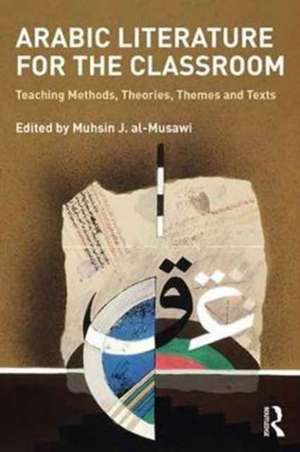Arabic Literature for the Classroom: Teaching Methods, Theories, Themes and Texts
Editat de Mushin al-Musawien Limba Engleză Paperback – mai 2017
The nineteen chapters which make up this book broach theoretical and methodical cultural concerns in teaching literatures from non-American cultures, along with issues of cross-cultural communication, cultural competency and translation. While some chapters bring out the fascinating and ever tantalizing connections between Arabic and the literatures of medieval Europe, others employ specific approaches to teaching particular texts, potential methodologies, themes and a variety of topics that can place Arabic widely in a vast swathe of academic application and learning. Topics that are explored include gender, race, class, trauma, exile, dislocation, love, rape, humor, and cinema, as well as issues that relate to writers and poets, women’s writing and the so called nahdah (revival) movement in the 19th Century.
The comparative framework and multi-disciplinary approach means that this book injects new life into the field of Arabic Literature. It will therefore be an essential resource for students, scholars and teachers of Arabic Literature, as well as for anyone with an interest in learning more about Arabic culture.
| Toate formatele și edițiile | Preț | Express |
|---|---|---|
| Paperback (1) | 471.29 lei 6-8 săpt. | |
| Taylor & Francis – mai 2017 | 471.29 lei 6-8 săpt. | |
| Hardback (1) | 766.65 lei 6-8 săpt. | |
| Taylor & Francis – 4 mai 2017 | 766.65 lei 6-8 săpt. |
Preț: 471.29 lei
Nou
Puncte Express: 707
Preț estimativ în valută:
90.19€ • 93.81$ • 74.46£
90.19€ • 93.81$ • 74.46£
Carte tipărită la comandă
Livrare economică 12-26 aprilie
Preluare comenzi: 021 569.72.76
Specificații
ISBN-13: 9781138211971
ISBN-10: 1138211974
Pagini: 344
Ilustrații: 8
Dimensiuni: 156 x 234 x 23 mm
Greutate: 0.5 kg
Ediția:1
Editura: Taylor & Francis
Colecția Routledge
Locul publicării:Oxford, United Kingdom
ISBN-10: 1138211974
Pagini: 344
Ilustrații: 8
Dimensiuni: 156 x 234 x 23 mm
Greutate: 0.5 kg
Ediția:1
Editura: Taylor & Francis
Colecția Routledge
Locul publicării:Oxford, United Kingdom
Public țintă
Postgraduate and UndergraduateCuprins
Introduction: Arabic Literature for the Classroom Part I:Theory and Method 1. Proxidistant Reading: Toward a Critical Pedagogy of the Nahḍah in U.S. Comparative Literary Studies 2. Teaching Arab Women’s Letters - 3. Arab Women Writers 1980-2010 4. Teaching Francophone Algerian Women’s Literature in a Bilingual French-English Context: Creative Voices, Dissident Texts 5. Teaching Classical Arabic Literature in English Translation 6. Classical and Post-Classical Arabic Literary Delights 7. Language through Literature Part II: Theme 8. Lessons from the Maghreb 9. Teaching Humor in Arabic Literature and Film 10. The Art of Teaching Arab Traumas Triumphantly 11. The Urban Gateway: Teaching the City in Modern Arabic Literature 12. Teaching Mahmud Darwish 13. Teaching the Modernist Arabic Poem in Translation 14. Lessons from a Revolution Part III: Text 15. Teaching the Maqamat in Translation 16. Ibn Hazm: Freindship, Love and the Quest for Justice 17. The Story of Zahra and its Critics 18. The Arabic Frametale and Two European Offspring 19. Teaching the Arabian Nights
Notă biografică
Muhsin J. al-Musawi is professor of Arabic and comparative studies at Columbia University and the author of many books in English and Arabic, including 'Arabic poetry'
Recenzii
This rich volume with its useful and original focus on teaching makes me wish I were teaching Arabic literature again. Including chapters by experts on all the major and many minor genres, the highly stimulating collection will be fruitfully read by teachers and students of Arabic and world literature. Geert Jan van Gelder, Laudian Professor of Arabic emeritus, University of Oxford.
This critically acute and pedagogically canny collection offers a host of ways to bring Arabic literature more fully into comparative and world literature classrooms, as well as in more specifically Middle Eastern courses. These essays offer new pathways into a wide range of classic and modern texts, in illuminating discussions that will be full of interest for teachers, scholars, and general readers alike. David Damrosch, Ernest Bernbaum Professor and Chair, Department of Comparative Literature, Harvard University
In this fine addition to a growing corpus of such materials, Muhsin al-Musawi and his colleagues have brought to bear on the teaching of Arabic literature a wide-ranging, high quality and apposite set of texts, insights, and best practices, designed to guide both novices and seasoned experts alike. Shawkat M. Toorawa, Professor of Arabic Literature, Yale University
This critically acute and pedagogically canny collection offers a host of ways to bring Arabic literature more fully into comparative and world literature classrooms, as well as in more specifically Middle Eastern courses. These essays offer new pathways into a wide range of classic and modern texts, in illuminating discussions that will be full of interest for teachers, scholars, and general readers alike. David Damrosch, Ernest Bernbaum Professor and Chair, Department of Comparative Literature, Harvard University
In this fine addition to a growing corpus of such materials, Muhsin al-Musawi and his colleagues have brought to bear on the teaching of Arabic literature a wide-ranging, high quality and apposite set of texts, insights, and best practices, designed to guide both novices and seasoned experts alike. Shawkat M. Toorawa, Professor of Arabic Literature, Yale University
Descriere
This book presents theoretical and methodical cultural concerns in teaching literatures from non-American cultures along with issues of cross-cultural communication, cultural competency and translation. Covering topics such as the 1001 Nights, Maqamat, Arabic poetry, women’s writing, classical poetics, issues of gender, race, and class, North African concerns, language acquisition through literature, Arab-spring writing, women’s correspondence, issues connected with the so called nahdah (revival) movement in the 19th century and many others, the book provides perspectives and topics that serve in both the planning of new courses and accommodation to already existing programs.
